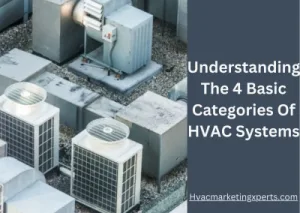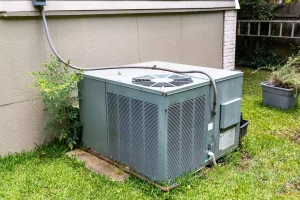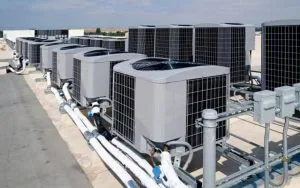
In today’s rapidly advancing world of technology, comfort, heating, ventilation, and air conditioning (HVAC) systems play a vital role in maintaining optimal indoor environments. From residential homes to large commercial spaces, these 4 basic categories of HVAC systems are designed to regulate temperature, ensure proper airflow, and enhance overall comfort.
As we delve into the realm of HVAC technology, it becomes apparent that these systems such as split systems, hybrid systems, ductless systems, and packaged systems can be classified into four fundamental categories, each serving distinct purposes and tailored to specific applications.
In this article, we will embark on a journey to unravel the intricacies of these 4 basic categories of HVAC systems, shedding light on their functionalities, advantages, and ideal use cases. Whether you’re a homeowner, a business owner, or simply curious about HVAC technology, this article will provide valuable insights into the heart of indoor climate control.

Generate More HVAC & Plumbing Leads with a Free 3-Week SEO Trial!
Ready to get more calls and customers for your HVAC or Plumbing business?
HVAC Marketing Xperts is offering contractors like you a LIMITED free SEO audit and a 1-on-1 marketing consultation tailored to your HVAC or plumbing business.
Our proven local SEO lead generation system is risk-free for 3 weeks (you pay nothing for three weeks of GBP and SEO services)!
Let’s grow your business together—click the button below to start now and claim the TIME-LIMITED offer.
The Four Basic Categories of HVAC Systems
HVAC (Heating, Ventilation, and Air Conditioning) systems play a pivotal role in maintaining indoor comfort and air quality in various environments, from homes to commercial spaces.
These systems can be classified into four fundamental categories, each designed to fulfill specific heating, cooling, and air circulation needs. Understanding these categories provides a foundational overview of HVAC technology and its applications.
Let’s explore the Four Basic Categories of HVAC Systems:
Split Systems

A split system HVAC is a type of heating and cooling system that consists of two main components known as an indoor unit and an outdoor unit. These units are connected by refrigerant lines that facilitate the transfer of heat.
The indoor unit includes the evaporator coil, blower, and air filter, while the outdoor unit contains the condenser coil and compressor. In cooling mode, the indoor unit absorbs heat from the indoor air, and the outdoor unit releases it to the outside. In heating mode, the process is reversed, with the indoor unit releasing heat into the indoor air.
Functionality and Applications:
Split systems are widely used in residential and small commercial spaces. They provide efficient cooling and heating by transferring heat between the indoor and outdoor units. The indoor unit circulates the conditioned air through the space, ensuring consistent comfort levels.
Split systems are versatile and can be configured as air conditioners or heat pumps, which offer both heating and cooling capabilities. They are suitable for individual rooms or open-plan areas, making them a popular choice for bedrooms, living rooms, offices, and small retail spaces.
Advantages and Disadvantages:
Advantages:
Disadvantages:
Packaged Systems

Packaged systems are comprehensive HVAC units that house all essential components for heating, cooling, and sometimes ventilation in a single, compact unit. Unlike split systems that have separate indoor and outdoor components, packaged systems are self-contained and typically installed outdoors or on rooftops.
These units are designed to efficiently condition air and maintain indoor comfort in a variety of settings, ranging from homes to commercial buildings.
Types within Packaged Systems
There are several types of packaged systems, each catering to specific needs and applications:
Pros and Cons:
Pros:
Cons:
Ductless Mini-Split Systems

Ductless mini-split systems, also known as ductless heat pumps or ductless air conditioners, are HVAC systems designed to provide both heating and cooling without the need for traditional ductwork. These systems consist of an outdoor condenser unit and one or more indoor air-handling units, which are often mounted on walls or ceilings in individual rooms or zones.
So, the indoor and outdoor units are connected by refrigerant lines, allowing the transfer of heat between them. Ductless mini-split systems are known for their flexibility, energy efficiency, and targeted comfort control.
Benefits in Specific Scenarios
Ductless mini-split systems offer several advantages in specific scenarios:
Considerations for Installation
When considering the installation of ductless mini-split systems, there are several important factors to keep in mind:
Hybrid Systems

Hybrid HVAC systems, also known as dual-fuel systems, are innovative solutions that combine two different heating technologies to optimize energy efficiency and cost savings. These systems typically integrate a traditional fuel-based heating source, such as a furnace or boiler, with an electric-powered heat pump.
The hybrid system intelligently selects the most efficient heating source based on outdoor conditions and energy costs, ensuring optimal performance and comfort.

Generate More HVAC & Plumbing Leads with a Free 3-Week SEO Trial!
Ready to get more calls and customers for your HVAC or Plumbing business?
HVAC Marketing Xperts is offering contractors like you a LIMITED free SEO audit and a 1-on-1 marketing consultation tailored to your HVAC or plumbing business.
Our proven local SEO lead generation system is risk-free for 3 weeks (you pay nothing for three weeks of GBP and SEO services)!
Let’s grow your business together—click the button below to start now and claim the TIME-LIMITED offer.
Combination of Technologies
Hybrid systems combine the following technologies:
The hybrid system utilizes the heat pump for heating during milder weather when it’s more energy-efficient, and switches to the furnace or boiler when outdoor temperatures drop significantly, ensuring effective heating performance even in extreme cold conditions.
Energy Efficiency and Cost Savings
Hybrid HVAC systems offer notable energy efficiency and cost-saving benefits:
It’s important to note that the effectiveness of a hybrid system depends on factors such as climate, energy prices, and system sizing. Proper installation, system setup, and regular maintenance by a qualified HVAC professional are crucial for maximizing the benefits of a hybrid HVAC system.
Factors to Consider When Choosing an HVAC System

Choosing the right HVAC system for your needs involves careful consideration of several factors to ensure optimal comfort, energy efficiency, and cost-effectiveness. Here are key factors to keep in mind:
Climate and Region:
The climate and region you live in significantly impact your HVAC needs. Consider the following:
Energy Efficiency Ratings
Energy efficiency is crucial for cost savings and environmental impact:
Initial Installation and Long-Term Maintenance Costs
Balancing upfront costs with long-term savings is important:
Space and Layout Considerations
Your building’s layout affects the HVAC system choice:
These factors provide a foundation for informed decision-making. It’s essential to assess your unique needs, preferences, and budget constraints when selecting an HVAC system. Consulting with HVAC professionals can help ensure you make the right choice for your specific circumstances.

Generate More HVAC & Plumbing Leads with a Free 3-Week SEO Trial!
Ready to get more calls and customers for your HVAC or Plumbing business?
HVAC Marketing Xperts is offering contractors like you a LIMITED free SEO audit and a 1-on-1 marketing consultation tailored to your HVAC or plumbing business.
Our proven local SEO lead generation system is risk-free for 3 weeks (you pay nothing for three weeks of GBP and SEO services)!
Let’s grow your business together—click the button below to start now and claim the TIME-LIMITED offer.
Conclusion
The 4 basic categories of HVAC systems known as the Split Systems, Packaged Systems, Ductless Mini-Split Systems, and Hybrid Systems offer diverse solutions to meet varying heating, cooling, and air circulation needs.
Each category presents distinct advantages and considerations, allowing for tailored choices based on factors such as space, climate, energy efficiency, and budget. By understanding these fundamental categories, individuals and businesses can make informed decisions to achieve optimal indoor comfort and environmental sustainability.
Latest Posts
- Service Works Review: Top Field Service Management SoftwareOur Service Works Review Overview ServiceWorks is a field service management software designed to make business operations easier. It handles scheduling, routing, inventory management, and payment processing tasks. By using ServiceWorks, businesses can save time, reduce costs, and improve efficiency. If you’re wondering what features make Service Works stand out, how it works, its pros… Read more: Service Works Review: Top Field Service Management Software
- Top 25 Best HVAC Software to Grow Your HVAC Business The HVAC industry has evolved over the past few years. Customers want to book jobs and stay updated on tech arrivals and technicians need a software solution to connect with the office team and maximize on-field operations. This all points to the fact that HVAC software is a necessity for any HVAC business looking to… Read more: Top 25 Best HVAC Software to Grow Your HVAC Business
- 2025 HVAC Trends: Rising Demand for HVAC Jobs/EducationThe HVAC (Heating, Ventilation, and Air Conditioning) industry is experiencing a significant surge in interest, particularly in education and job opportunities. Our recent analysis of over 30 keywords related to “HVAC School,” “HVAC Trade,” and “HVAC Jobs” reveals a growing trend of people seeking to enter this lucrative field. We gathered this data to write… Read more: 2025 HVAC Trends: Rising Demand for HVAC Jobs/Education
- 9 HVAC Valentine’s Day Marketing IdeasLooking for unique HVAC Valentine’s Day marketing ideas? You’re in the right place and we’ll show you practical ways to market your business. Valentine’s Day is probably around the corner and you’ve been searching for ways to promote your HVAC services. But so far you’ve come up with nothing. It’s normal because you have so… Read more: 9 HVAC Valentine’s Day Marketing Ideas
- 8 HVAC Summer Ad Strategies that Actually WorkDuring the summer most homeowners keep their air conditioners running throughout the day because of the hot weather conditions. This is the period when HVAC companies receive a lot of calls for AC repairs and tune-ups. And running HVAC summer ads will help you to reach more people in your service location. We’ve provided some… Read more: 8 HVAC Summer Ad Strategies that Actually Work
- 9 HVAC Landing Page Best PracticesEffectively reaching a target audience is a difficult undertaking for any business. For HVAC businesses, the landing page is that critical first impression after a click that plays a crucial role in turning visitors into leads. A HVAC landing page is designed to draw attention to a particular service and subsequently generate leads. It is… Read more: 9 HVAC Landing Page Best Practices
- 120 Plumbing company slogan ideas Introducing your brand as a plumbing company will do little to differentiate you from your competitors. You will need great messaging that leaves a lasting impression on your target market. Slogans are a clever addition to your marketing toolkit that communicates your values and offerings to your potential customers. They are short phrases that show… Read more: 120 Plumbing company slogan ideas
- 210 Catchy HVAC Slogan Ideas & ExamplesHVAC Slogan Ideas for Heating Ventilation and Air Conditioning Company One way to distinguish your HVAC business in an industry where everyone seems to be offering similar services is through HVAC marketing. Words are a critical element in HVAC business marketing and can be used in different marketing strategies: websites, advertisements, social media, email, etc. … Read more: 210 Catchy HVAC Slogan Ideas & Examples
- 10 Best HVAC Website Design Ideas (+How to Build One)How to Build an Effective HVAC Website If you think of your HVAC website as a virtual sales representative, you’ll make it as cool as your HVAC services. A website is one of the important components of your company’s marketing strategy and online identity. A well-designed HVAC website benefits your HVAC business by attracting customers, … Read more: 10 Best HVAC Website Design Ideas (+How to Build One)
- Google Ads for HVAC Companies: 9 Strategies & Best PracticesGoogle Ads for HVAC Companies: How to Get More Leads and Customers Formally Google Adwords; Google Ads are shown to about 90% of internet users globally. Meaning? You can both have a vast reach and a highly focused campaign within your service location. Without having to spend ridiculous amounts of money and waste a lot of… Read more: Google Ads for HVAC Companies: 9 Strategies & Best Practices
- HVAC Facebook Ads Strategy: 7 Tips to Get More CustomersBest HVAC Facebook Ads Strategies to Acquire More Customers Why Facebook marketing for Heating, Ventilation, and Air Conditioning companies? Most homeowners and commercial businesses are on Facebook making it a viable ground for residential and commercial HVAC companies. Running Facebook Ads for HVAC contractors will amplify your marketing efforts by helping you to reach unique… Read more: HVAC Facebook Ads Strategy: 7 Tips to Get More Customers
- Best 7 Funny HVAC Commercials in (month)15 Funny HVAC Ads That Are Amazing and Effective HVAC commercials offer a short time to spark interest in your business and deliver a world-class sales pitch; funny HVAC ads will help you to do both. Coming up with funny HVAC ideas can be exhausting so we scoured the web and found 15 funny HVAC… Read more: Best 7 Funny HVAC Commercials in (month)
- 15 Winter HVAC Advertising Ideas that Made Our Client $300k11 Creative Winter HVAC Ad Ideas to Try Out this Year As the year begins to draw to an end, temperatures hit a new low, and the need for a heating solution becomes prevalent. Winter is here, which means that heat pumps and furnaces are left on for hours resulting in the need for tune-ups… Read more: 15 Winter HVAC Advertising Ideas that Made Our Client $300k
- 10 Social Media Marketing Tips for PlumbersSocial Media for Plumbers: The Ultimate Guide We live in a digital era, where people can leisurely connect with reliable businesses to meet their everyday needs from the comfort of their homes. Social media is an online platform that shapes how business owners, including plumbing businesses, attract and connect with customers. About 66% of Facebook… Read more: 10 Social Media Marketing Tips for Plumbers
- 20 Best Plumbing Website Designs [+Tips to Create Your Own]Plumbing Websites: Web Design Ideas and Examples for Plumbers Think of your website as a professional sales representative capable of generating good leads and increasing conversion rates. A great website design is a sure way to distinguish and grow your plumbing business and turn leads into paying customers. We all agree that designing a website… Read more: 20 Best Plumbing Website Designs [+Tips to Create Your Own]
- Plumbing Ads: 20 Plumber Advertising Tips to Get New ClientsPlumbing Advertising: Ad Ideas and Examples for Plumbers Plumbing is an essential service for residential and commercial purposes, but it is also a competitive industry. If you want to grow your plumbing business, attract potential customers, and stay on top of your game, you must prioritize advertising. Advertising your plumbing business online will help your… Read more: Plumbing Ads: 20 Plumber Advertising Tips to Get New Clients














![20 Best Plumbing Website Designs [+Tips to Create Your Own] 14 plumBing websites design ideas - by Hvac marketing xperts](https://hvacmarketingxperts.com/wp-content/uploads/plumBing-websites-design-ideas-by-Hvac-marketing-xperts-150x150.webp)
